Context of Human Services: Addressing Inequality in Australia Report
VerifiedAdded on 2022/08/22
|11
|2278
|15
Report
AI Summary
This report, submitted by a student, addresses the issue of inequality in Australia. The paper begins by outlining the existing challenges, including income disparities, access to resources, and the impact of social changes on the economy. It then proposes specific changes to address these issues, such as encouraging women's participation in the workforce, supporting sole-parent households, improving pension systems, providing unemployment assistance, and ensuring access to housing. The report further discusses the expected benefits of these changes, including structural development, better access to education, sustainability of economic resources, and increased employment opportunities. Additionally, it analyzes the strengths and weaknesses of the proposed changes, considering both positive outcomes like reduced income inequality and improved life expectancy, as well as potential drawbacks such as increased public spending and the complexity of implementing new social policies. The report concludes by emphasizing the need for continuous monitoring and stringent regulations to ensure the effectiveness of social policies and promote sustainable economic growth, suggesting a focus on pension systems, individual participation in economic development, and the effective role of government agencies.
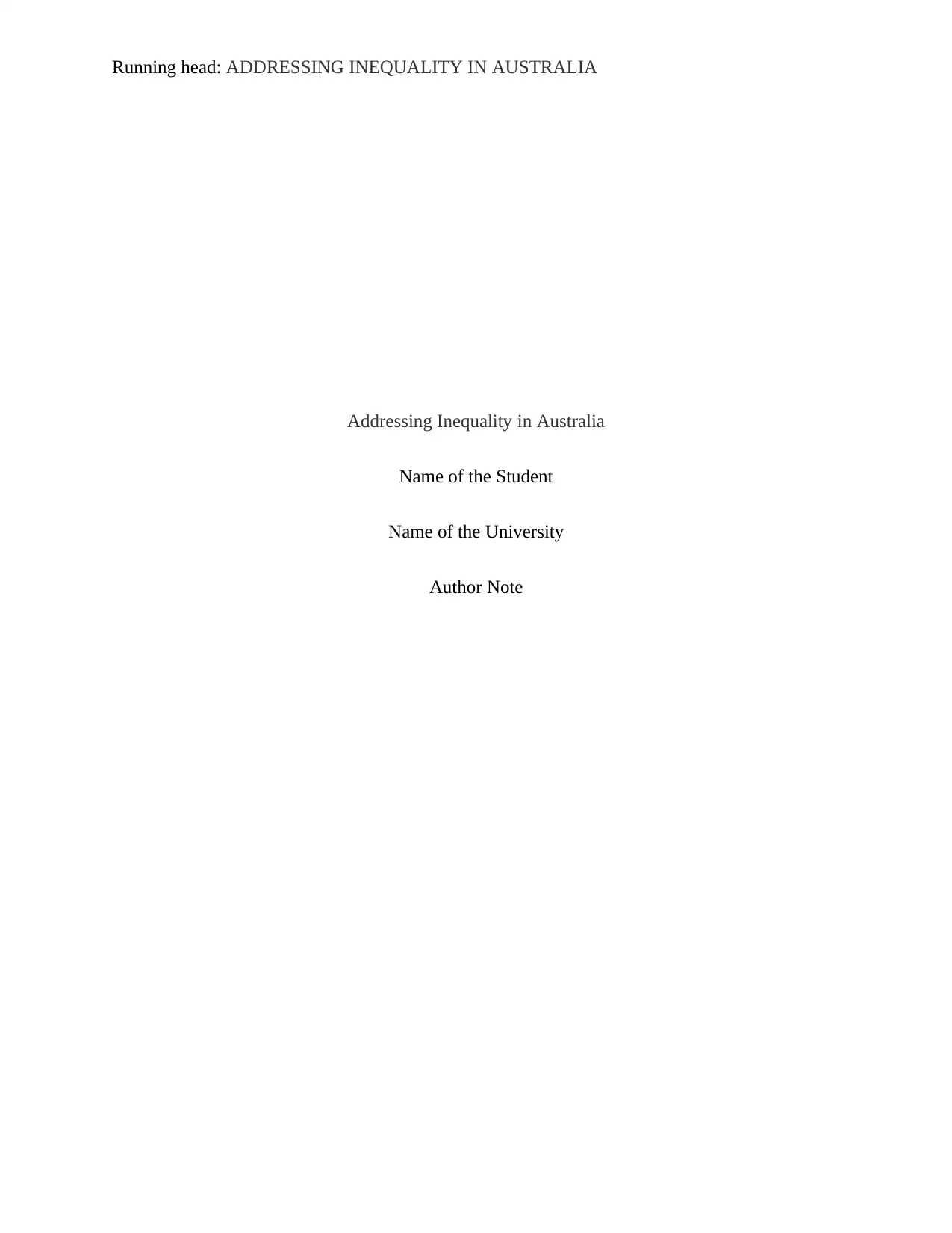
Running head: ADDRESSING INEQUALITY IN AUSTRALIA
Addressing Inequality in Australia
Name of the Student
Name of the University
Author Note
Addressing Inequality in Australia
Name of the Student
Name of the University
Author Note
Paraphrase This Document
Need a fresh take? Get an instant paraphrase of this document with our AI Paraphraser
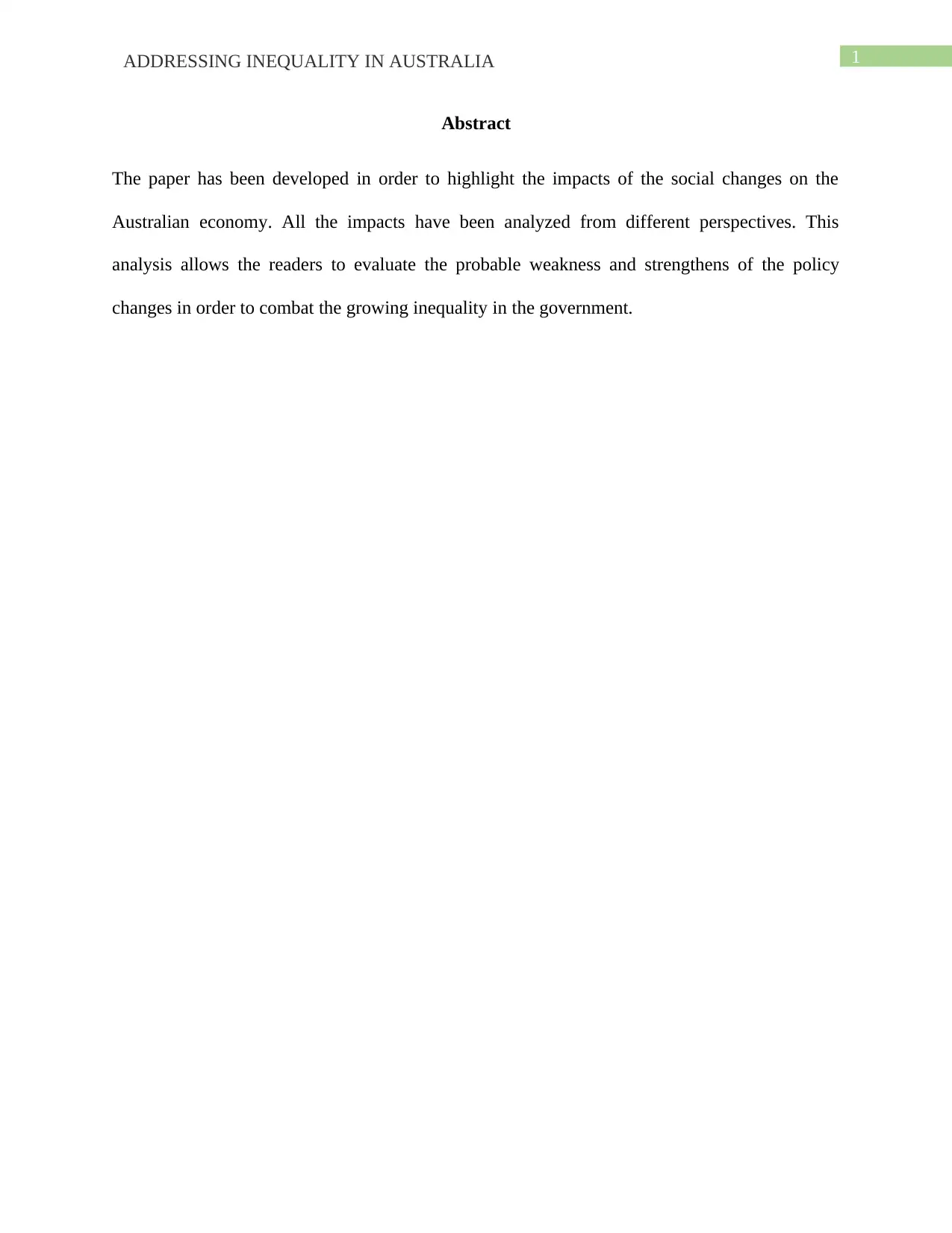
1ADDRESSING INEQUALITY IN AUSTRALIA
Abstract
The paper has been developed in order to highlight the impacts of the social changes on the
Australian economy. All the impacts have been analyzed from different perspectives. This
analysis allows the readers to evaluate the probable weakness and strengthens of the policy
changes in order to combat the growing inequality in the government.
Abstract
The paper has been developed in order to highlight the impacts of the social changes on the
Australian economy. All the impacts have been analyzed from different perspectives. This
analysis allows the readers to evaluate the probable weakness and strengthens of the policy
changes in order to combat the growing inequality in the government.
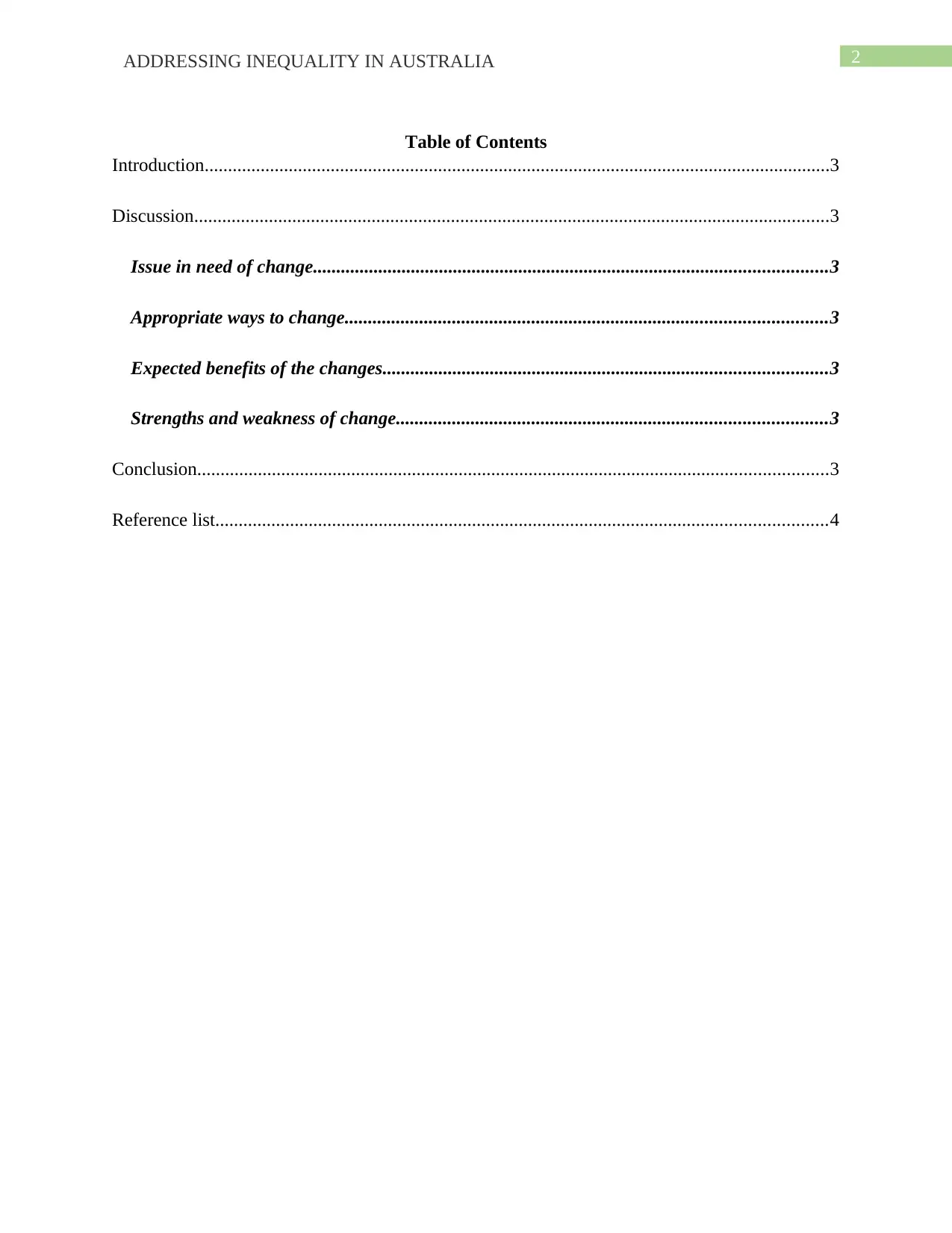
2ADDRESSING INEQUALITY IN AUSTRALIA
Table of Contents
Introduction......................................................................................................................................3
Discussion........................................................................................................................................3
Issue in need of change..............................................................................................................3
Appropriate ways to change.......................................................................................................3
Expected benefits of the changes...............................................................................................3
Strengths and weakness of change............................................................................................3
Conclusion.......................................................................................................................................3
Reference list...................................................................................................................................4
Table of Contents
Introduction......................................................................................................................................3
Discussion........................................................................................................................................3
Issue in need of change..............................................................................................................3
Appropriate ways to change.......................................................................................................3
Expected benefits of the changes...............................................................................................3
Strengths and weakness of change............................................................................................3
Conclusion.......................................................................................................................................3
Reference list...................................................................................................................................4
⊘ This is a preview!⊘
Do you want full access?
Subscribe today to unlock all pages.

Trusted by 1+ million students worldwide
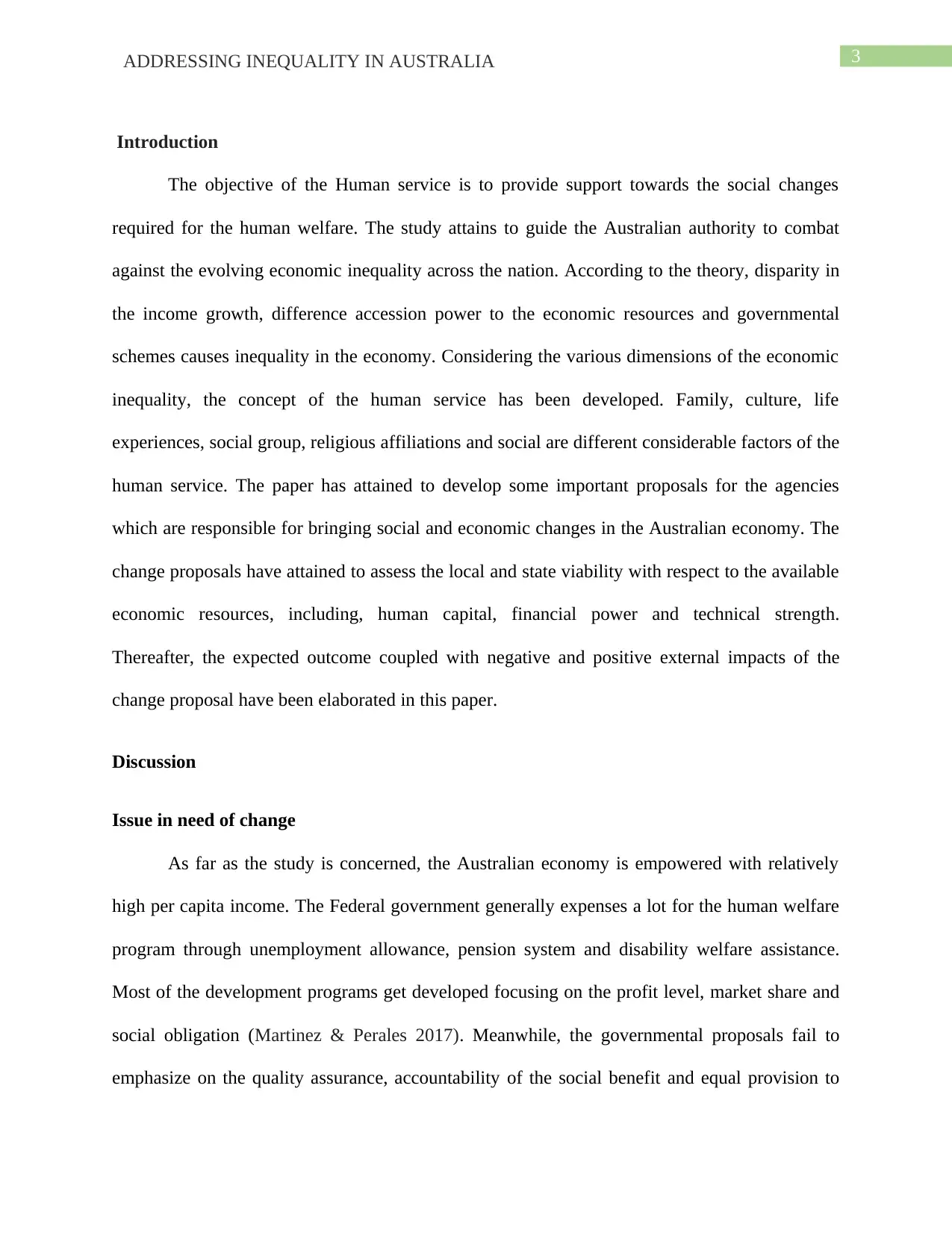
3ADDRESSING INEQUALITY IN AUSTRALIA
Introduction
The objective of the Human service is to provide support towards the social changes
required for the human welfare. The study attains to guide the Australian authority to combat
against the evolving economic inequality across the nation. According to the theory, disparity in
the income growth, difference accession power to the economic resources and governmental
schemes causes inequality in the economy. Considering the various dimensions of the economic
inequality, the concept of the human service has been developed. Family, culture, life
experiences, social group, religious affiliations and social are different considerable factors of the
human service. The paper has attained to develop some important proposals for the agencies
which are responsible for bringing social and economic changes in the Australian economy. The
change proposals have attained to assess the local and state viability with respect to the available
economic resources, including, human capital, financial power and technical strength.
Thereafter, the expected outcome coupled with negative and positive external impacts of the
change proposal have been elaborated in this paper.
Discussion
Issue in need of change
As far as the study is concerned, the Australian economy is empowered with relatively
high per capita income. The Federal government generally expenses a lot for the human welfare
program through unemployment allowance, pension system and disability welfare assistance.
Most of the development programs get developed focusing on the profit level, market share and
social obligation (Martinez & Perales 2017). Meanwhile, the governmental proposals fail to
emphasize on the quality assurance, accountability of the social benefit and equal provision to
Introduction
The objective of the Human service is to provide support towards the social changes
required for the human welfare. The study attains to guide the Australian authority to combat
against the evolving economic inequality across the nation. According to the theory, disparity in
the income growth, difference accession power to the economic resources and governmental
schemes causes inequality in the economy. Considering the various dimensions of the economic
inequality, the concept of the human service has been developed. Family, culture, life
experiences, social group, religious affiliations and social are different considerable factors of the
human service. The paper has attained to develop some important proposals for the agencies
which are responsible for bringing social and economic changes in the Australian economy. The
change proposals have attained to assess the local and state viability with respect to the available
economic resources, including, human capital, financial power and technical strength.
Thereafter, the expected outcome coupled with negative and positive external impacts of the
change proposal have been elaborated in this paper.
Discussion
Issue in need of change
As far as the study is concerned, the Australian economy is empowered with relatively
high per capita income. The Federal government generally expenses a lot for the human welfare
program through unemployment allowance, pension system and disability welfare assistance.
Most of the development programs get developed focusing on the profit level, market share and
social obligation (Martinez & Perales 2017). Meanwhile, the governmental proposals fail to
emphasize on the quality assurance, accountability of the social benefit and equal provision to
Paraphrase This Document
Need a fresh take? Get an instant paraphrase of this document with our AI Paraphraser
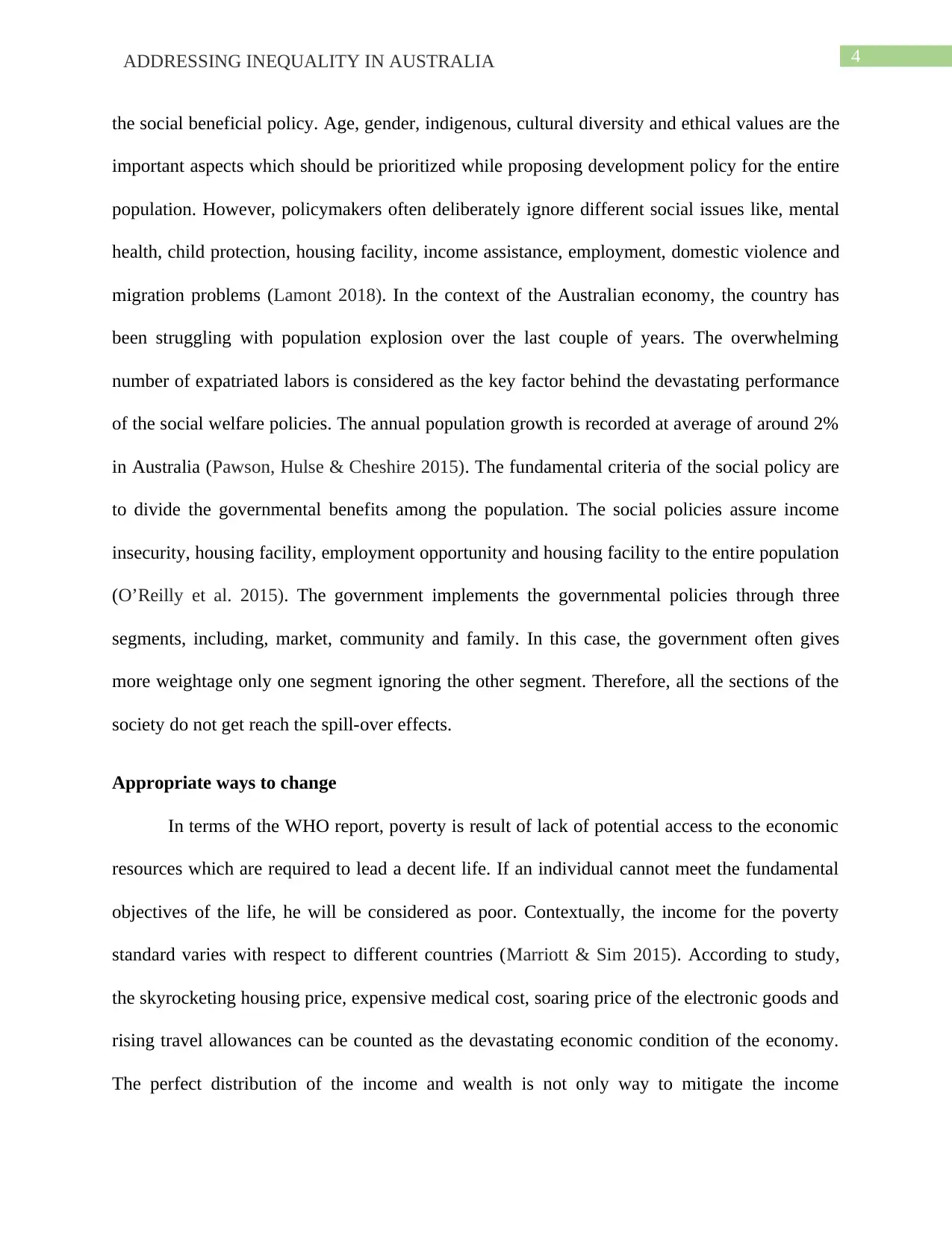
4ADDRESSING INEQUALITY IN AUSTRALIA
the social beneficial policy. Age, gender, indigenous, cultural diversity and ethical values are the
important aspects which should be prioritized while proposing development policy for the entire
population. However, policymakers often deliberately ignore different social issues like, mental
health, child protection, housing facility, income assistance, employment, domestic violence and
migration problems (Lamont 2018). In the context of the Australian economy, the country has
been struggling with population explosion over the last couple of years. The overwhelming
number of expatriated labors is considered as the key factor behind the devastating performance
of the social welfare policies. The annual population growth is recorded at average of around 2%
in Australia (Pawson, Hulse & Cheshire 2015). The fundamental criteria of the social policy are
to divide the governmental benefits among the population. The social policies assure income
insecurity, housing facility, employment opportunity and housing facility to the entire population
(O’Reilly et al. 2015). The government implements the governmental policies through three
segments, including, market, community and family. In this case, the government often gives
more weightage only one segment ignoring the other segment. Therefore, all the sections of the
society do not get reach the spill-over effects.
Appropriate ways to change
In terms of the WHO report, poverty is result of lack of potential access to the economic
resources which are required to lead a decent life. If an individual cannot meet the fundamental
objectives of the life, he will be considered as poor. Contextually, the income for the poverty
standard varies with respect to different countries (Marriott & Sim 2015). According to study,
the skyrocketing housing price, expensive medical cost, soaring price of the electronic goods and
rising travel allowances can be counted as the devastating economic condition of the economy.
The perfect distribution of the income and wealth is not only way to mitigate the income
the social beneficial policy. Age, gender, indigenous, cultural diversity and ethical values are the
important aspects which should be prioritized while proposing development policy for the entire
population. However, policymakers often deliberately ignore different social issues like, mental
health, child protection, housing facility, income assistance, employment, domestic violence and
migration problems (Lamont 2018). In the context of the Australian economy, the country has
been struggling with population explosion over the last couple of years. The overwhelming
number of expatriated labors is considered as the key factor behind the devastating performance
of the social welfare policies. The annual population growth is recorded at average of around 2%
in Australia (Pawson, Hulse & Cheshire 2015). The fundamental criteria of the social policy are
to divide the governmental benefits among the population. The social policies assure income
insecurity, housing facility, employment opportunity and housing facility to the entire population
(O’Reilly et al. 2015). The government implements the governmental policies through three
segments, including, market, community and family. In this case, the government often gives
more weightage only one segment ignoring the other segment. Therefore, all the sections of the
society do not get reach the spill-over effects.
Appropriate ways to change
In terms of the WHO report, poverty is result of lack of potential access to the economic
resources which are required to lead a decent life. If an individual cannot meet the fundamental
objectives of the life, he will be considered as poor. Contextually, the income for the poverty
standard varies with respect to different countries (Marriott & Sim 2015). According to study,
the skyrocketing housing price, expensive medical cost, soaring price of the electronic goods and
rising travel allowances can be counted as the devastating economic condition of the economy.
The perfect distribution of the income and wealth is not only way to mitigate the income
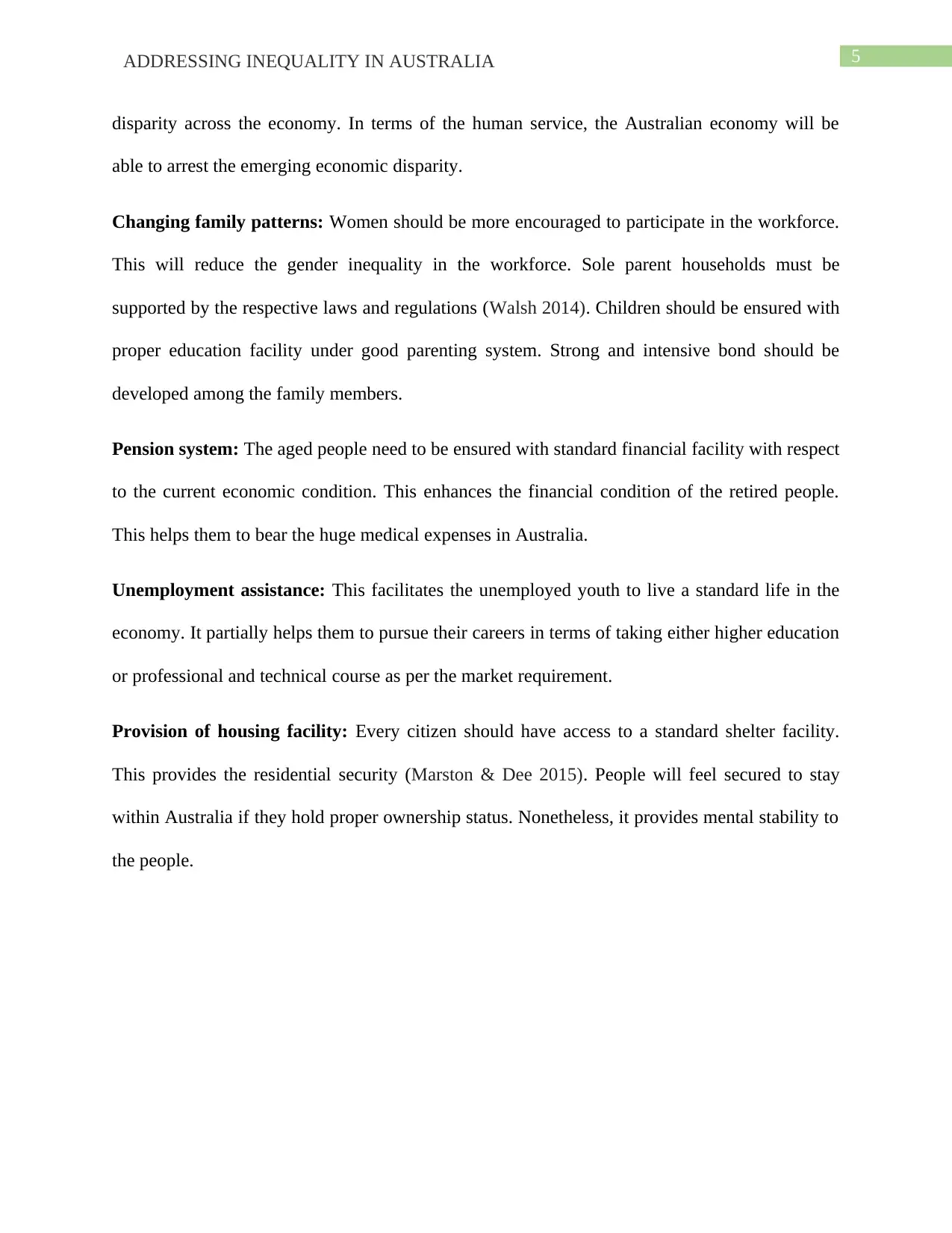
5ADDRESSING INEQUALITY IN AUSTRALIA
disparity across the economy. In terms of the human service, the Australian economy will be
able to arrest the emerging economic disparity.
Changing family patterns: Women should be more encouraged to participate in the workforce.
This will reduce the gender inequality in the workforce. Sole parent households must be
supported by the respective laws and regulations (Walsh 2014). Children should be ensured with
proper education facility under good parenting system. Strong and intensive bond should be
developed among the family members.
Pension system: The aged people need to be ensured with standard financial facility with respect
to the current economic condition. This enhances the financial condition of the retired people.
This helps them to bear the huge medical expenses in Australia.
Unemployment assistance: This facilitates the unemployed youth to live a standard life in the
economy. It partially helps them to pursue their careers in terms of taking either higher education
or professional and technical course as per the market requirement.
Provision of housing facility: Every citizen should have access to a standard shelter facility.
This provides the residential security (Marston & Dee 2015). People will feel secured to stay
within Australia if they hold proper ownership status. Nonetheless, it provides mental stability to
the people.
disparity across the economy. In terms of the human service, the Australian economy will be
able to arrest the emerging economic disparity.
Changing family patterns: Women should be more encouraged to participate in the workforce.
This will reduce the gender inequality in the workforce. Sole parent households must be
supported by the respective laws and regulations (Walsh 2014). Children should be ensured with
proper education facility under good parenting system. Strong and intensive bond should be
developed among the family members.
Pension system: The aged people need to be ensured with standard financial facility with respect
to the current economic condition. This enhances the financial condition of the retired people.
This helps them to bear the huge medical expenses in Australia.
Unemployment assistance: This facilitates the unemployed youth to live a standard life in the
economy. It partially helps them to pursue their careers in terms of taking either higher education
or professional and technical course as per the market requirement.
Provision of housing facility: Every citizen should have access to a standard shelter facility.
This provides the residential security (Marston & Dee 2015). People will feel secured to stay
within Australia if they hold proper ownership status. Nonetheless, it provides mental stability to
the people.
⊘ This is a preview!⊘
Do you want full access?
Subscribe today to unlock all pages.

Trusted by 1+ million students worldwide
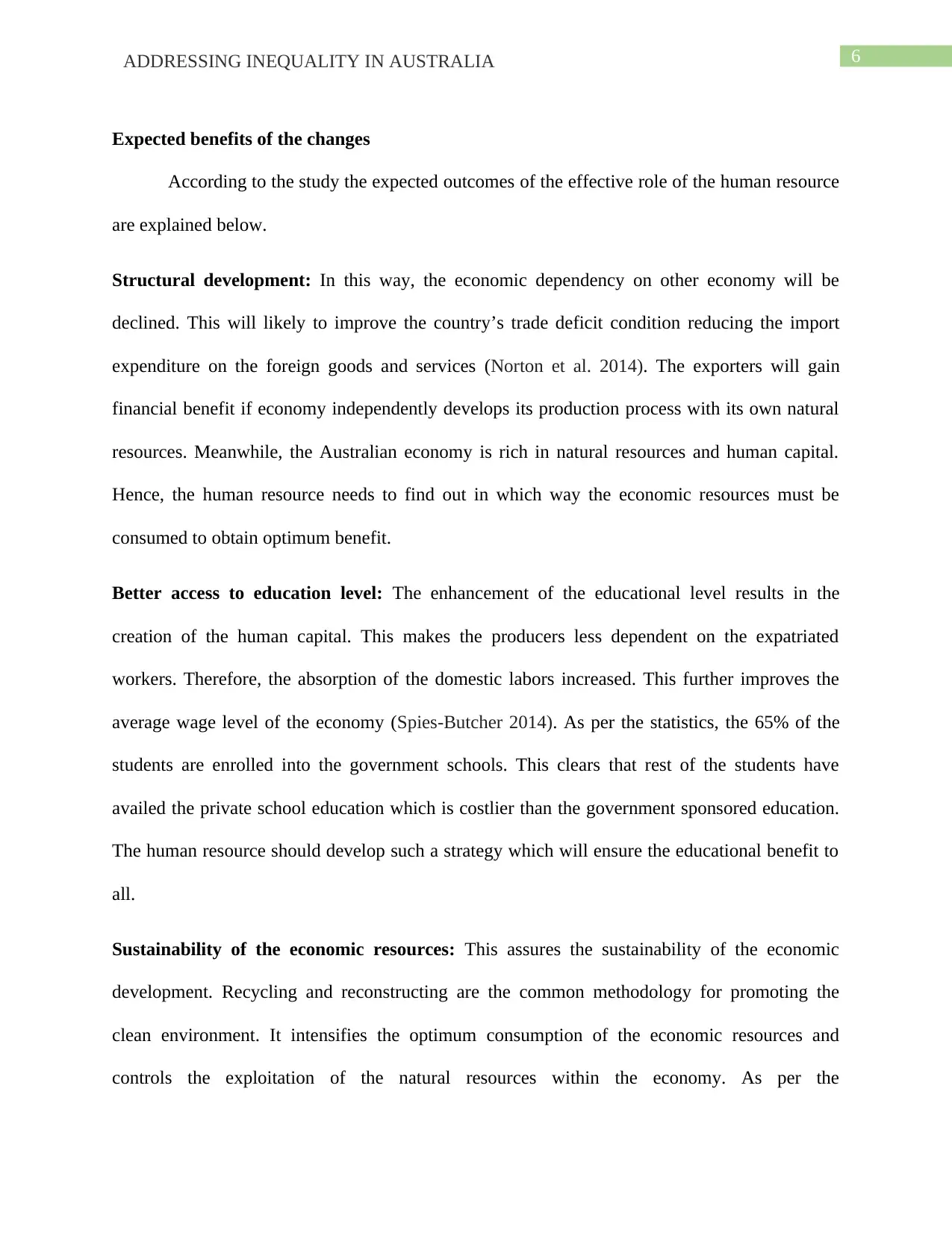
6ADDRESSING INEQUALITY IN AUSTRALIA
Expected benefits of the changes
According to the study the expected outcomes of the effective role of the human resource
are explained below.
Structural development: In this way, the economic dependency on other economy will be
declined. This will likely to improve the country’s trade deficit condition reducing the import
expenditure on the foreign goods and services (Norton et al. 2014). The exporters will gain
financial benefit if economy independently develops its production process with its own natural
resources. Meanwhile, the Australian economy is rich in natural resources and human capital.
Hence, the human resource needs to find out in which way the economic resources must be
consumed to obtain optimum benefit.
Better access to education level: The enhancement of the educational level results in the
creation of the human capital. This makes the producers less dependent on the expatriated
workers. Therefore, the absorption of the domestic labors increased. This further improves the
average wage level of the economy (Spies-Butcher 2014). As per the statistics, the 65% of the
students are enrolled into the government schools. This clears that rest of the students have
availed the private school education which is costlier than the government sponsored education.
The human resource should develop such a strategy which will ensure the educational benefit to
all.
Sustainability of the economic resources: This assures the sustainability of the economic
development. Recycling and reconstructing are the common methodology for promoting the
clean environment. It intensifies the optimum consumption of the economic resources and
controls the exploitation of the natural resources within the economy. As per the
Expected benefits of the changes
According to the study the expected outcomes of the effective role of the human resource
are explained below.
Structural development: In this way, the economic dependency on other economy will be
declined. This will likely to improve the country’s trade deficit condition reducing the import
expenditure on the foreign goods and services (Norton et al. 2014). The exporters will gain
financial benefit if economy independently develops its production process with its own natural
resources. Meanwhile, the Australian economy is rich in natural resources and human capital.
Hence, the human resource needs to find out in which way the economic resources must be
consumed to obtain optimum benefit.
Better access to education level: The enhancement of the educational level results in the
creation of the human capital. This makes the producers less dependent on the expatriated
workers. Therefore, the absorption of the domestic labors increased. This further improves the
average wage level of the economy (Spies-Butcher 2014). As per the statistics, the 65% of the
students are enrolled into the government schools. This clears that rest of the students have
availed the private school education which is costlier than the government sponsored education.
The human resource should develop such a strategy which will ensure the educational benefit to
all.
Sustainability of the economic resources: This assures the sustainability of the economic
development. Recycling and reconstructing are the common methodology for promoting the
clean environment. It intensifies the optimum consumption of the economic resources and
controls the exploitation of the natural resources within the economy. As per the
Paraphrase This Document
Need a fresh take? Get an instant paraphrase of this document with our AI Paraphraser
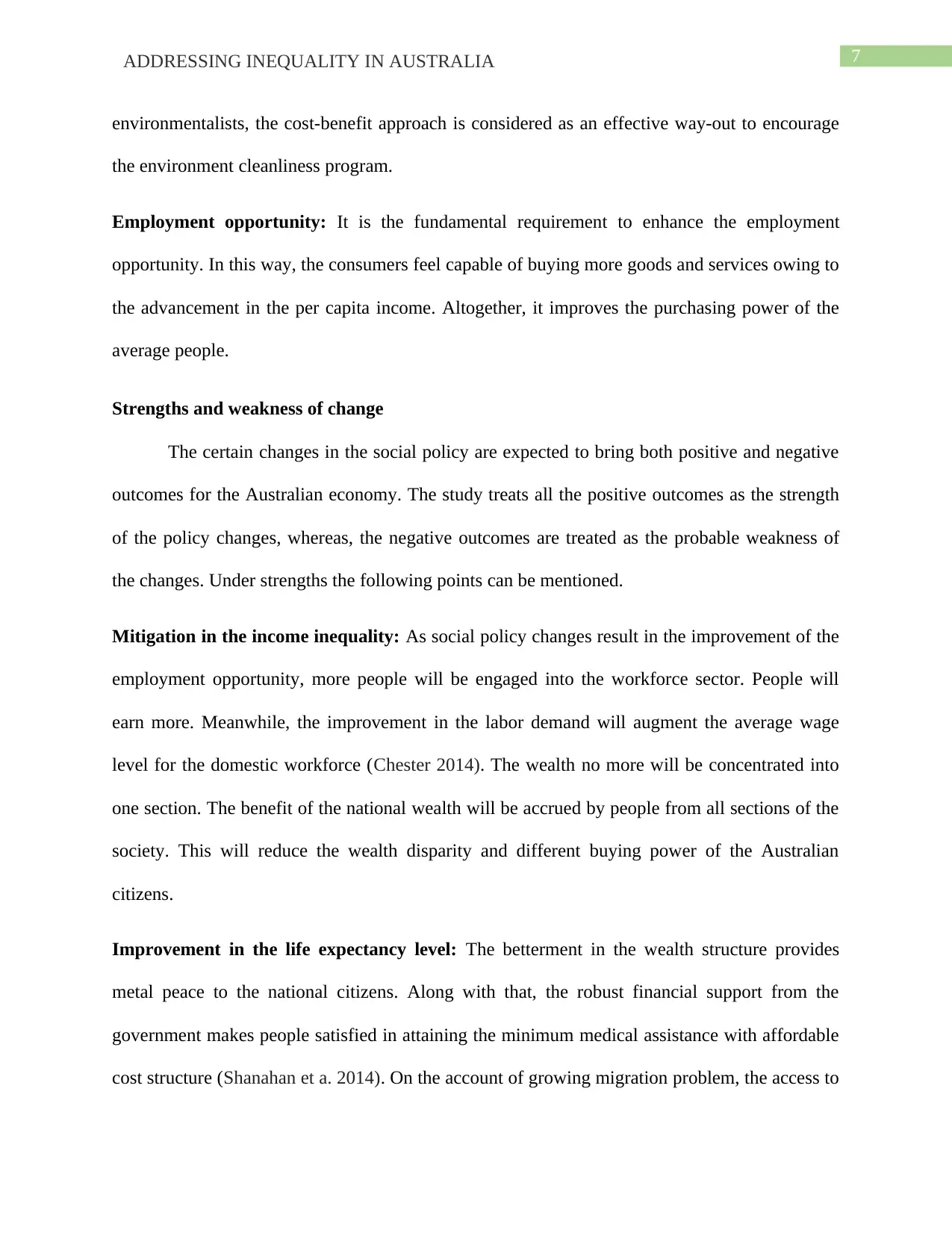
7ADDRESSING INEQUALITY IN AUSTRALIA
environmentalists, the cost-benefit approach is considered as an effective way-out to encourage
the environment cleanliness program.
Employment opportunity: It is the fundamental requirement to enhance the employment
opportunity. In this way, the consumers feel capable of buying more goods and services owing to
the advancement in the per capita income. Altogether, it improves the purchasing power of the
average people.
Strengths and weakness of change
The certain changes in the social policy are expected to bring both positive and negative
outcomes for the Australian economy. The study treats all the positive outcomes as the strength
of the policy changes, whereas, the negative outcomes are treated as the probable weakness of
the changes. Under strengths the following points can be mentioned.
Mitigation in the income inequality: As social policy changes result in the improvement of the
employment opportunity, more people will be engaged into the workforce sector. People will
earn more. Meanwhile, the improvement in the labor demand will augment the average wage
level for the domestic workforce (Chester 2014). The wealth no more will be concentrated into
one section. The benefit of the national wealth will be accrued by people from all sections of the
society. This will reduce the wealth disparity and different buying power of the Australian
citizens.
Improvement in the life expectancy level: The betterment in the wealth structure provides
metal peace to the national citizens. Along with that, the robust financial support from the
government makes people satisfied in attaining the minimum medical assistance with affordable
cost structure (Shanahan et a. 2014). On the account of growing migration problem, the access to
environmentalists, the cost-benefit approach is considered as an effective way-out to encourage
the environment cleanliness program.
Employment opportunity: It is the fundamental requirement to enhance the employment
opportunity. In this way, the consumers feel capable of buying more goods and services owing to
the advancement in the per capita income. Altogether, it improves the purchasing power of the
average people.
Strengths and weakness of change
The certain changes in the social policy are expected to bring both positive and negative
outcomes for the Australian economy. The study treats all the positive outcomes as the strength
of the policy changes, whereas, the negative outcomes are treated as the probable weakness of
the changes. Under strengths the following points can be mentioned.
Mitigation in the income inequality: As social policy changes result in the improvement of the
employment opportunity, more people will be engaged into the workforce sector. People will
earn more. Meanwhile, the improvement in the labor demand will augment the average wage
level for the domestic workforce (Chester 2014). The wealth no more will be concentrated into
one section. The benefit of the national wealth will be accrued by people from all sections of the
society. This will reduce the wealth disparity and different buying power of the Australian
citizens.
Improvement in the life expectancy level: The betterment in the wealth structure provides
metal peace to the national citizens. Along with that, the robust financial support from the
government makes people satisfied in attaining the minimum medical assistance with affordable
cost structure (Shanahan et a. 2014). On the account of growing migration problem, the access to
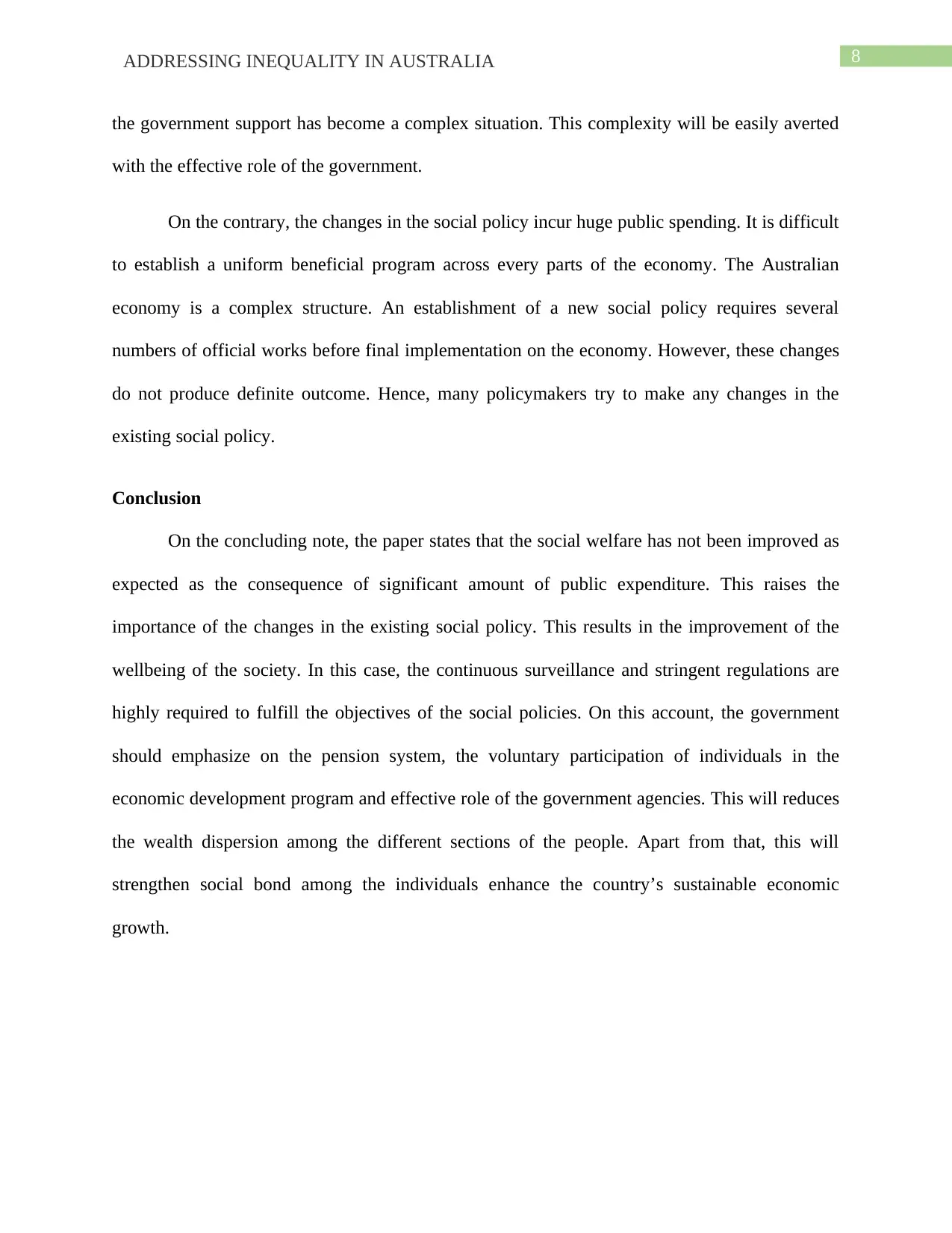
8ADDRESSING INEQUALITY IN AUSTRALIA
the government support has become a complex situation. This complexity will be easily averted
with the effective role of the government.
On the contrary, the changes in the social policy incur huge public spending. It is difficult
to establish a uniform beneficial program across every parts of the economy. The Australian
economy is a complex structure. An establishment of a new social policy requires several
numbers of official works before final implementation on the economy. However, these changes
do not produce definite outcome. Hence, many policymakers try to make any changes in the
existing social policy.
Conclusion
On the concluding note, the paper states that the social welfare has not been improved as
expected as the consequence of significant amount of public expenditure. This raises the
importance of the changes in the existing social policy. This results in the improvement of the
wellbeing of the society. In this case, the continuous surveillance and stringent regulations are
highly required to fulfill the objectives of the social policies. On this account, the government
should emphasize on the pension system, the voluntary participation of individuals in the
economic development program and effective role of the government agencies. This will reduces
the wealth dispersion among the different sections of the people. Apart from that, this will
strengthen social bond among the individuals enhance the country’s sustainable economic
growth.
the government support has become a complex situation. This complexity will be easily averted
with the effective role of the government.
On the contrary, the changes in the social policy incur huge public spending. It is difficult
to establish a uniform beneficial program across every parts of the economy. The Australian
economy is a complex structure. An establishment of a new social policy requires several
numbers of official works before final implementation on the economy. However, these changes
do not produce definite outcome. Hence, many policymakers try to make any changes in the
existing social policy.
Conclusion
On the concluding note, the paper states that the social welfare has not been improved as
expected as the consequence of significant amount of public expenditure. This raises the
importance of the changes in the existing social policy. This results in the improvement of the
wellbeing of the society. In this case, the continuous surveillance and stringent regulations are
highly required to fulfill the objectives of the social policies. On this account, the government
should emphasize on the pension system, the voluntary participation of individuals in the
economic development program and effective role of the government agencies. This will reduces
the wealth dispersion among the different sections of the people. Apart from that, this will
strengthen social bond among the individuals enhance the country’s sustainable economic
growth.
⊘ This is a preview!⊘
Do you want full access?
Subscribe today to unlock all pages.

Trusted by 1+ million students worldwide
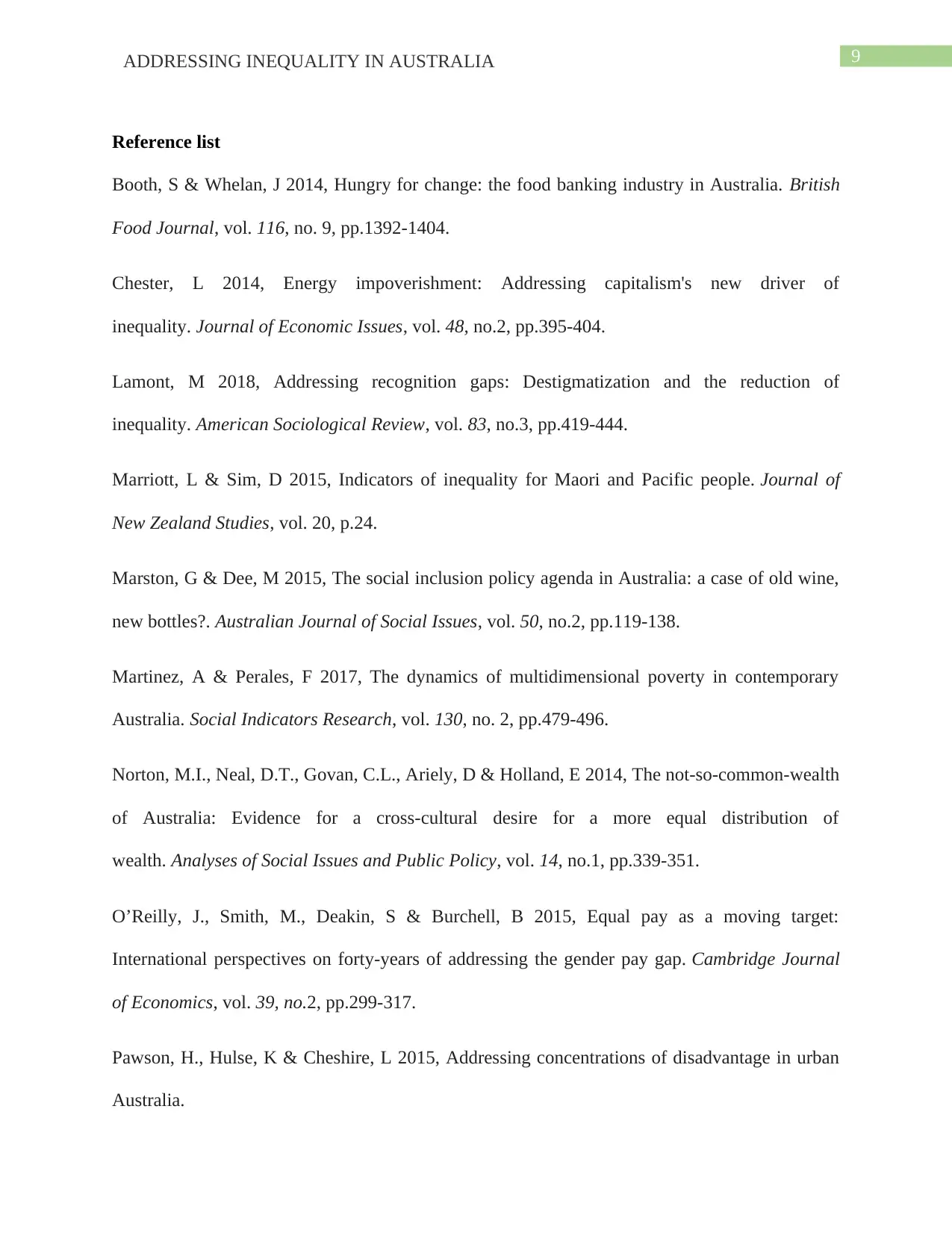
9ADDRESSING INEQUALITY IN AUSTRALIA
Reference list
Booth, S & Whelan, J 2014, Hungry for change: the food banking industry in Australia. British
Food Journal, vol. 116, no. 9, pp.1392-1404.
Chester, L 2014, Energy impoverishment: Addressing capitalism's new driver of
inequality. Journal of Economic Issues, vol. 48, no.2, pp.395-404.
Lamont, M 2018, Addressing recognition gaps: Destigmatization and the reduction of
inequality. American Sociological Review, vol. 83, no.3, pp.419-444.
Marriott, L & Sim, D 2015, Indicators of inequality for Maori and Pacific people. Journal of
New Zealand Studies, vol. 20, p.24.
Marston, G & Dee, M 2015, The social inclusion policy agenda in Australia: a case of old wine,
new bottles?. Australian Journal of Social Issues, vol. 50, no.2, pp.119-138.
Martinez, A & Perales, F 2017, The dynamics of multidimensional poverty in contemporary
Australia. Social Indicators Research, vol. 130, no. 2, pp.479-496.
Norton, M.I., Neal, D.T., Govan, C.L., Ariely, D & Holland, E 2014, The not‐so‐common‐wealth
of Australia: Evidence for a cross‐cultural desire for a more equal distribution of
wealth. Analyses of Social Issues and Public Policy, vol. 14, no.1, pp.339-351.
O’Reilly, J., Smith, M., Deakin, S & Burchell, B 2015, Equal pay as a moving target:
International perspectives on forty-years of addressing the gender pay gap. Cambridge Journal
of Economics, vol. 39, no.2, pp.299-317.
Pawson, H., Hulse, K & Cheshire, L 2015, Addressing concentrations of disadvantage in urban
Australia.
Reference list
Booth, S & Whelan, J 2014, Hungry for change: the food banking industry in Australia. British
Food Journal, vol. 116, no. 9, pp.1392-1404.
Chester, L 2014, Energy impoverishment: Addressing capitalism's new driver of
inequality. Journal of Economic Issues, vol. 48, no.2, pp.395-404.
Lamont, M 2018, Addressing recognition gaps: Destigmatization and the reduction of
inequality. American Sociological Review, vol. 83, no.3, pp.419-444.
Marriott, L & Sim, D 2015, Indicators of inequality for Maori and Pacific people. Journal of
New Zealand Studies, vol. 20, p.24.
Marston, G & Dee, M 2015, The social inclusion policy agenda in Australia: a case of old wine,
new bottles?. Australian Journal of Social Issues, vol. 50, no.2, pp.119-138.
Martinez, A & Perales, F 2017, The dynamics of multidimensional poverty in contemporary
Australia. Social Indicators Research, vol. 130, no. 2, pp.479-496.
Norton, M.I., Neal, D.T., Govan, C.L., Ariely, D & Holland, E 2014, The not‐so‐common‐wealth
of Australia: Evidence for a cross‐cultural desire for a more equal distribution of
wealth. Analyses of Social Issues and Public Policy, vol. 14, no.1, pp.339-351.
O’Reilly, J., Smith, M., Deakin, S & Burchell, B 2015, Equal pay as a moving target:
International perspectives on forty-years of addressing the gender pay gap. Cambridge Journal
of Economics, vol. 39, no.2, pp.299-317.
Pawson, H., Hulse, K & Cheshire, L 2015, Addressing concentrations of disadvantage in urban
Australia.
Paraphrase This Document
Need a fresh take? Get an instant paraphrase of this document with our AI Paraphraser
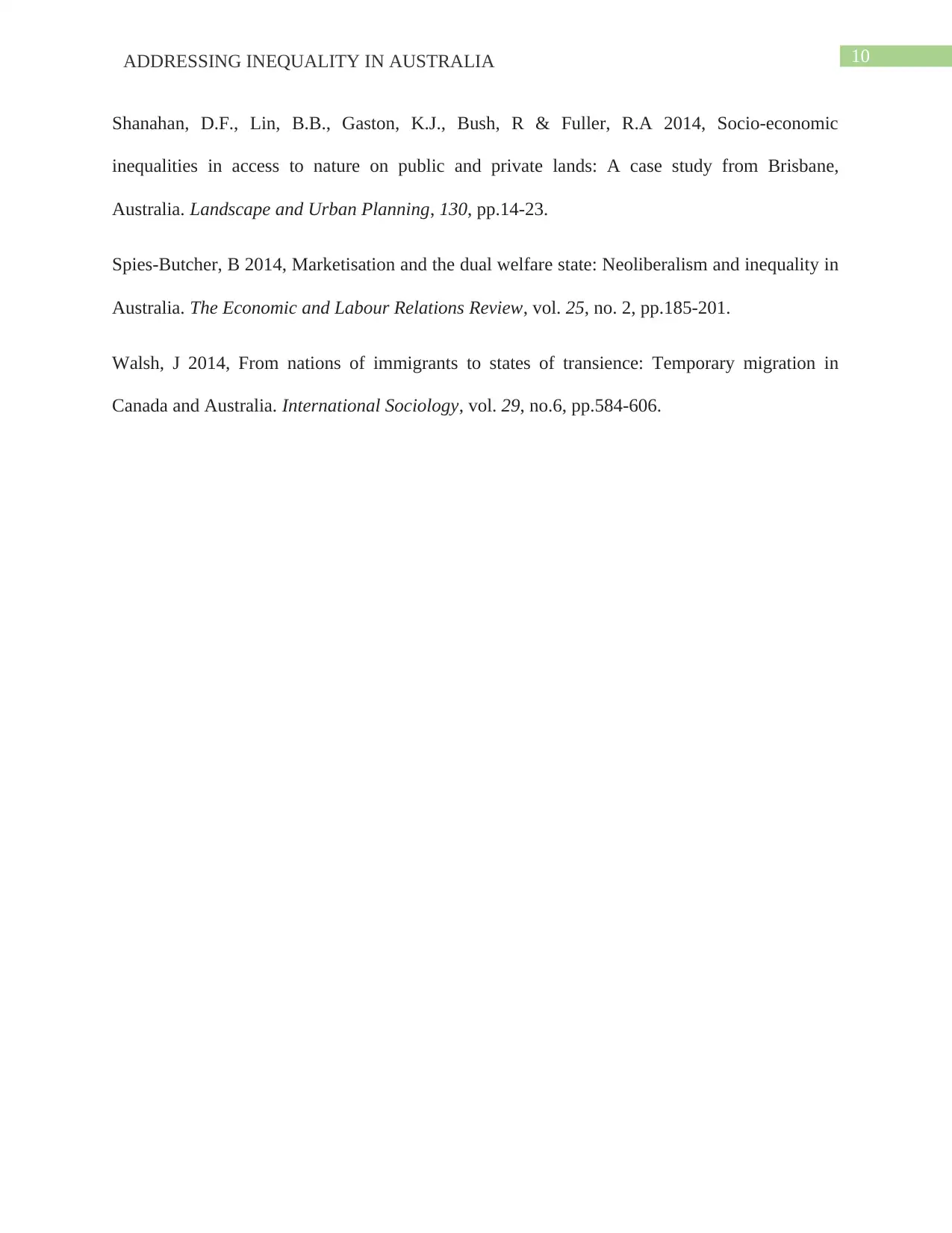
10ADDRESSING INEQUALITY IN AUSTRALIA
Shanahan, D.F., Lin, B.B., Gaston, K.J., Bush, R & Fuller, R.A 2014, Socio-economic
inequalities in access to nature on public and private lands: A case study from Brisbane,
Australia. Landscape and Urban Planning, 130, pp.14-23.
Spies-Butcher, B 2014, Marketisation and the dual welfare state: Neoliberalism and inequality in
Australia. The Economic and Labour Relations Review, vol. 25, no. 2, pp.185-201.
Walsh, J 2014, From nations of immigrants to states of transience: Temporary migration in
Canada and Australia. International Sociology, vol. 29, no.6, pp.584-606.
Shanahan, D.F., Lin, B.B., Gaston, K.J., Bush, R & Fuller, R.A 2014, Socio-economic
inequalities in access to nature on public and private lands: A case study from Brisbane,
Australia. Landscape and Urban Planning, 130, pp.14-23.
Spies-Butcher, B 2014, Marketisation and the dual welfare state: Neoliberalism and inequality in
Australia. The Economic and Labour Relations Review, vol. 25, no. 2, pp.185-201.
Walsh, J 2014, From nations of immigrants to states of transience: Temporary migration in
Canada and Australia. International Sociology, vol. 29, no.6, pp.584-606.
1 out of 11
Related Documents
Your All-in-One AI-Powered Toolkit for Academic Success.
+13062052269
info@desklib.com
Available 24*7 on WhatsApp / Email
![[object Object]](/_next/static/media/star-bottom.7253800d.svg)
Unlock your academic potential
Copyright © 2020–2025 A2Z Services. All Rights Reserved. Developed and managed by ZUCOL.





